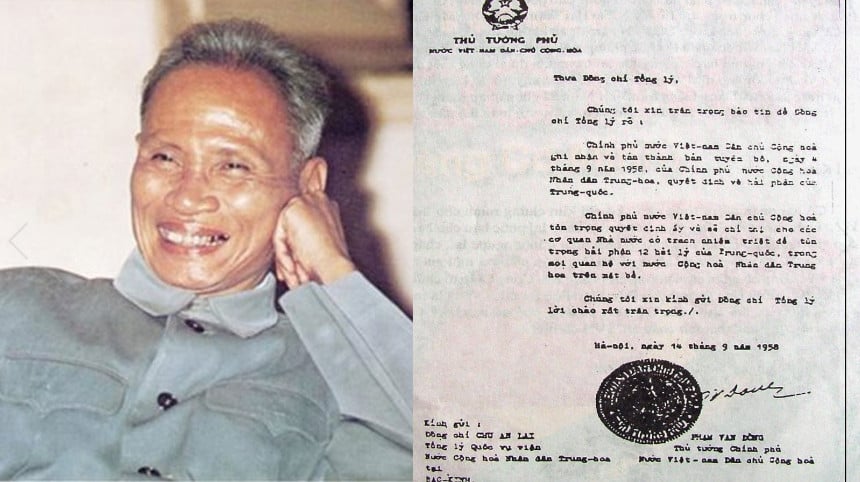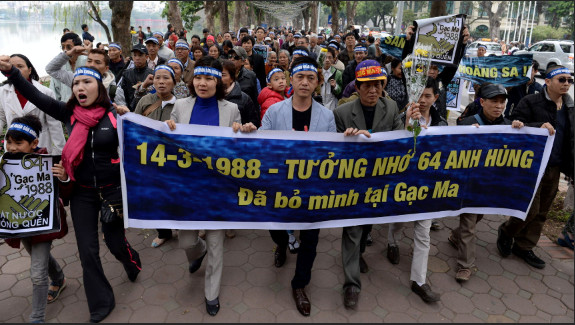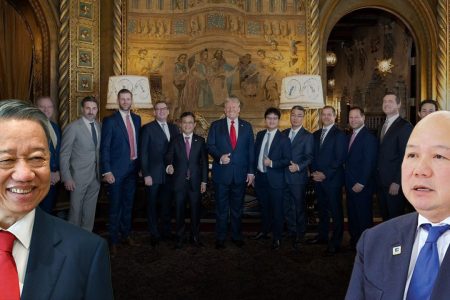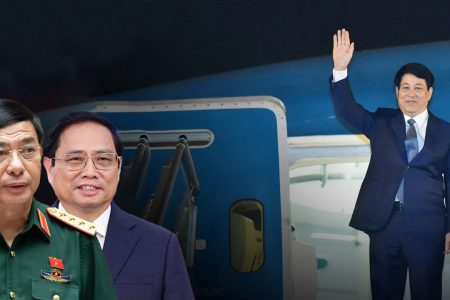The situation of the East Sea (South China Sea) is still very hot by the continuous aggressive actions of China. After announcing the establishment of the „Xisha“ and „Nansha“ administrative bodies of the Hoang Sa (Paracels) and the Truong Sa (Spratlys) on April 18, China continued to take bold steps. On April 17, China sent a Note to respond to Vietnam’s March 30’s note with a threatening sentence: China resolutely asks Vietnam to withdraw all people and objects on the islands and rocks in the Spratlys.
Commentators say that the recent move means a possibility that China could use force at any time, as in previous occasions in 1974 (attacking Paracels) and 1988 (attacking South Johnson reef in Spratlys) from Vietnam.

In addition, China’s Ministry of Civil Affairs on April 19 made another blatant announcement of the so-called „standard title“ for 25 islands, rocky beaches and 55 undersea geographical features in the western part of the South China Sea. Some are located along the „cow’s tongue line“ and are very close to Vietnam.
For example, Nhan Dam Hai Dai (Xiantan Haitai), about 60 nautical miles from Cam Ranh; Van An Hai De Hap Coc Quan (Wan’an Haidixiaguqun) is about 50 nautical miles from Phu Quy island; Tieu Tuong Hai Khau (Xiaoxiang Haiqiu) is about 45 nautical miles from Hon Hai.
This move once again shows that China increasingly expresses its ambition to monopolize the South China Sea while simultaneously taking actions in the field, in law and in administration.
What does China’s note on April 17 show?
On March 30, 2020, Vietnam sent a diplomatic note to assert its sovereignty over the Paracels and Spratlys as well as to protest China’s ridiculous and illegal arguments in the South China Sea. At the same time, on April 14, 2020, Vietnam also sent two more notes to respond to the views of Malaysia and the Philippines.
On April 17, 2020, China sent a note to the United Nations in response. In addition to reiterating its previous objections to Malaysia, the Philippines and Vietnam, China also reiterated that Vietnam had acknowledged China’s sovereignty over the Paracels and Spratlys with then Vietnamese Prime Minister Pham Van Dong’s 1958 Official Letter. In addition, China also said that, until the 1970s, the Vietnamese side had always officially recognized the two archipelagos as part of China’s long-standing territory.
China stated that: „On September 4, 1958, the Chinese government issued the Declaration of a Twelve nautical mile territorial sea, This Regulation applies to all territories of the People’s Republic of China. including the Paracels, Spratlys, Scarborough Shoal and all other islands of China.

“On September 14, 1958, Prime Minister Pham Van Dong of Vietnam sent a diplomatic note to Zhou Enlai, Premier of the State Council of China, solemnly stating that “the government of the Democratic Republic of Vietnam recognizes and supports the declaration of the Government of the People’s Republic of China on its decision concerning China’s territorial sea made on September 4 1958 and that ‘the government of the Democratic Republic of Vietnam respects this decision.’”
The Chinese note stated such a legal basis.
In addition, China also said that after 1975, Vietnam violated the principle of estoppel (ie, not contrary to the previous words) in international law because of illegal acts of claiming to the Paracels and the Spratlys. China insists that Vietnam has used illegal force to seize the Spratly Islands and rocks, which belong to China.
In particular, in this note of China has one more sentence: „China resolutely demands that Vietnam withdraw all the crews and facilities from islands and reefs it has invaded and illegally occupied.”
Immediately after sending the above note, on April 18, China issued a declaration to establish the so-called Xisha and Nansha districts to manage the Paracels and Spratlys of Vietnam, taking the Chinese-occupied Cross Rock Reef Vietnam to make the headquarters of the government (government agency) managing these two districts.
It seems that China has triggered a new phase in its expansion in the South China Sea. This can be considered a signal that China may increase coercive measures or resort to force against other claimant states.
In the article of Nguyen Hong Thao – former Vietnam ambassador in Malaysia published on April 19, 2020, the author poses the possibility that this is a signal that China will use force against Vietnam. It is worth noting that there were no similar threats in China’s replies to the Philippines and Malaysia.
According to the search of the Great Project to Sign the South China Sea, a statement from the Chinese Foreign Ministry Spokesperson on February 22, 1988 contained a similar sentence: „The Vietnamese side must withdraw from the islands and coral clusters. If the Vietnamese side blocks China’s legitimate actions in the aforementioned areas, regardless of China’s consistency, then (Vietnam) will be fully responsible for the consequences arising.“
And as we all know, China declared this sentence on February 22, 1988. On March 14, 1988, the Chinese Navy massacred Vietnamese soldiers in Gac Ma (South Johnson reef). Therefore, being alert to the signals threatening to use Chinese force at this time is not redundant.
How are Chinese scenarios for the use of force to occur?

So if China used force, how would it use force? Here are two possibilities.
1. China will open fire and take control of 21 structures that Vietnam is holding in Spratlys. This scenario may occur, but with very little likelihood, because:
i) The Chinese navy’s capabilities are growing, but the Vietnamese Navy has also made strides in quality and quantity. We should know, if merely comparing the potential of the two sides, it is a limp. But China can only bring a portion of its naval potential to fight the Vietnamese Navy here.
ii) Vietnam’s position and power were not the same as in 1988. With the support of Vietnam from other countries in the world, including the US, it showed that Vietnam still has the support of many international friends.
iii) This is not a good time for China to wage a war. The US and China are in a „heroic“ strategic battle with each other. With irresponsible and risky actions to take advantage of the Covid-19 pandemic, many Western countries have supported the US. If China goes to war this time, it will be an opportunity for the world to take side with the US, and China will be isolated. This China does not want. What China wants is not to fight and still achieve its goal of monopolizing the South China Sea. Therefore, this situation is unlikely to occur now.
2. However, China has the ability to use its fleets, from Navy warships to Coast Guards ships, fishermen and its navy militia ships to threaten and encircle the Vietnamese platforms near the Vanguard Bank area that Vietnam is currently controlling. The „cabbage“ scenario that China successfully applied to gain the upper hand, gaining control at Scarborough from the Philippines in 2012 could be repeated, in a new form.
Therefore, Vietnam needs to have coping scenarios in the worst-case scenario.
Commenting on the situation on April 20, 2020 from Hanoi, Dr. Tran Cong Truc, former head of the Government of Vietnam Border Committee, told BBC News Vietnamese:
„I think China’s moves aim for new and strong acts in coming times. It is likely China will use combination of military, civil, economic and technical measures often called soft war to force other countries to acknowledge their irrational claims.”
“In my opinion we do not exclude the possibility that China suddenly takes simultaneous or consecutive military actions at these two points. Beijing may cause troubles in many points to hide their major targets.”
„This includes sending research ships to the contested South China Sea in the name of freedom of navigation, according to the provisions of the International Convention on the Law of the Sea.”
“They will do something, but it may cause some attention, distracting them, so that they can conduct another more powerful activity, in another area, in which the Taiwan Strait issue is not exclude this possibility.”
On the same day, April 20, Dr. Ha Hoang Hop, a senior researcher at the Institute of Southeast Asian Studies (ISEAS, Singapore), told the BBC:
“Japan, Australia and India act under the Indo-Pacific framework. In addition, Japan and Australia operate on the basis of US strategic allies.
“Asean countries, there are four countries with rights disputes in the South China Sea, these countries are negotiating with all six other ASEAN countries to negotiate the Code of Conduct in the South China Sea (COC) with China but have no desired results.”
“So far, all countries, including Japan, Australia, and India, have pursued peaceful measures.”
„The USS America amphibious assault ship and the USS Bunker Hill guided missile cruiser have been deployed and are operating in the South China Sea,“ Indian-Pacific Command Spokeswoman Nicole Schwegman told Reuters.
“China always considers its calculations and actions towards the South China Sea feasible. Up to now, actions based on China’s force, illegal occupation of islands, embankment, militarization in the South China Sea, and other illegal activities have all the results that China wants.
“The international community, in my opinion, has never taken any feasible measures to stop China in the South China Sea. The countries in dispute in the South China Sea have so far only Philippines sued China, but the ruling of the Permanent Court of Arbitration (PCA) 2016 for the Philippines was not recognized and followed by China.”
“China’s declaration in the South China Sea is ambiguous for China to monopolize the South China Sea. They used several terms in 1982 to seem legal, but actually has no legal meaning. In 2017, China added some groups of islands and reefs to its declaration, nothing else.”
Is China ready to „attack“ or not?
Regarding the situation regarding the Spratlys and the Taiwan Strait, especially recent developments in the South China Sea and the region, Dr. Ha Hoang Hop commented:
“It can be seen in the policy, from the statements of Chinese leaders from 2012 to the present, from military force dispositions, from militarization in the South China Sea, and the Taiwan Strait, we can see that China Quoc was ready to attack Taiwan and attack Vietnam in the Spratlys.”
“The declaration of establishing two districts in the South China Sea on April 17, 2020 naturally is preparations to use force to capture mainly in Spratly whenever China sees it possible.
“Vietnam is prepared to respond to all situations in relations with China, including those related to the South China Sea. The Vietnamese tradition shows that if Vietnam was invaded, Vietnam would defend the country and chase away the aggressors.“
Also during this period, the head of the state, Mr. Nguyen Phu Trong, was almost absent from the political field, so what will PM Nguyen Xuan Phuc and his government have to do? Prepare for the worst case scenario, when war with China could occur in the South China Sea.
China asks the Vietnamese army to immediately withdraw from the islands – the diplomatic note from Pham Van Dong
Thu Thuy from Hochiminh city – Thoibao.de (Translated)
























